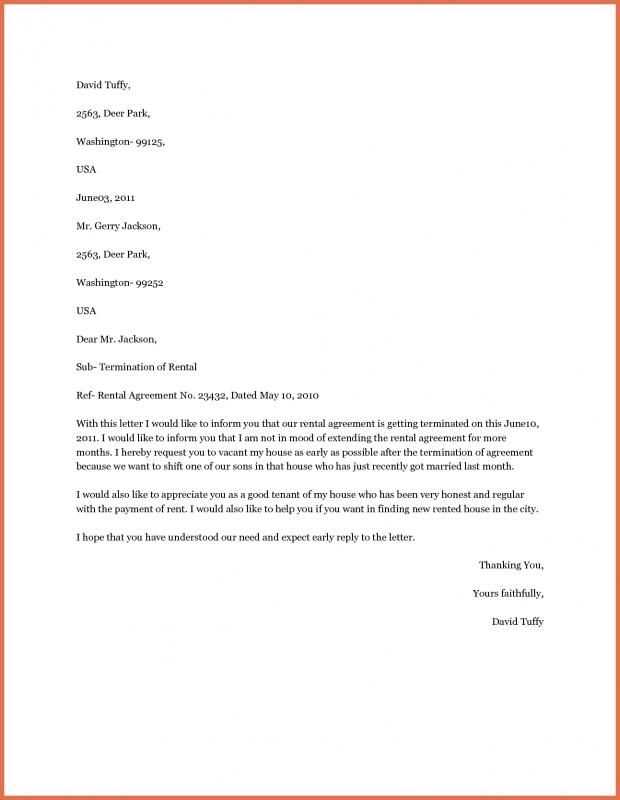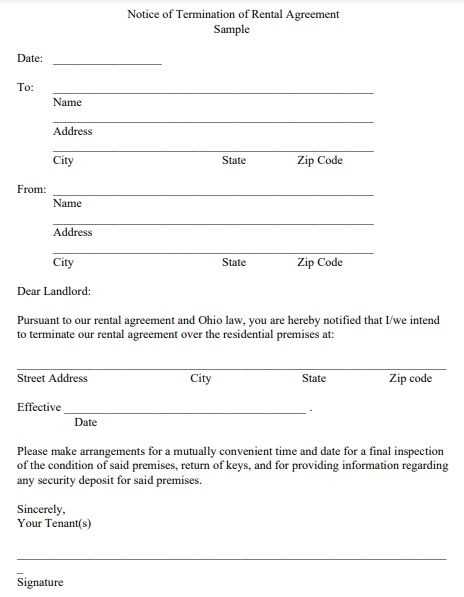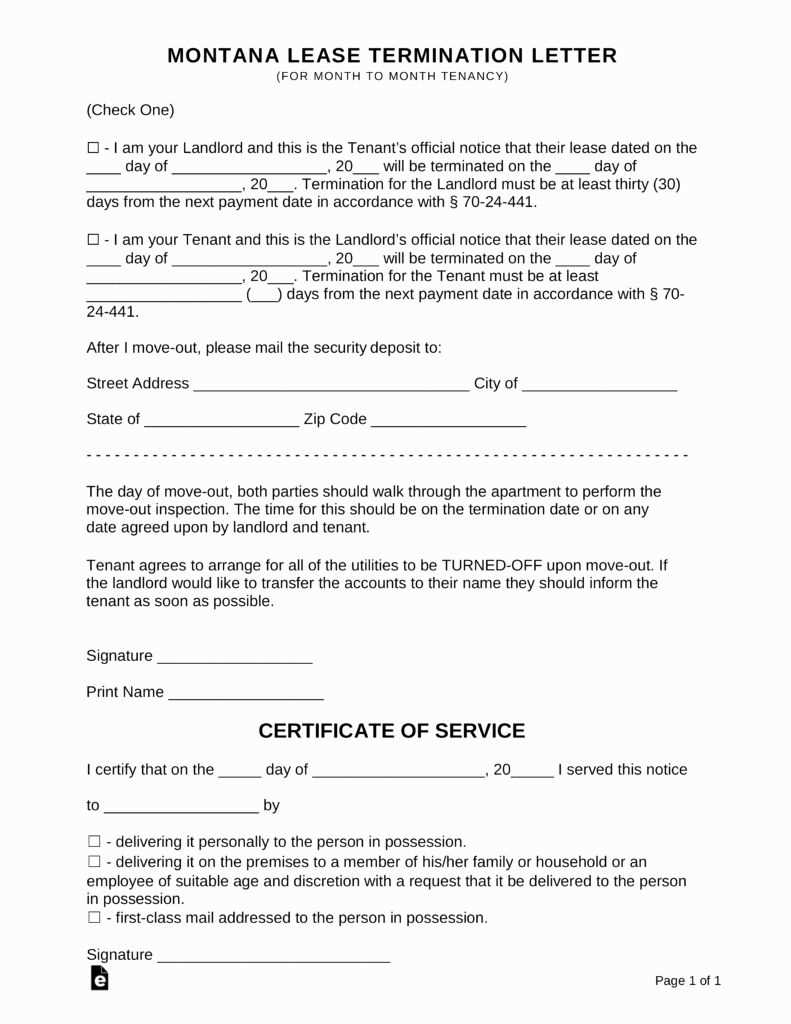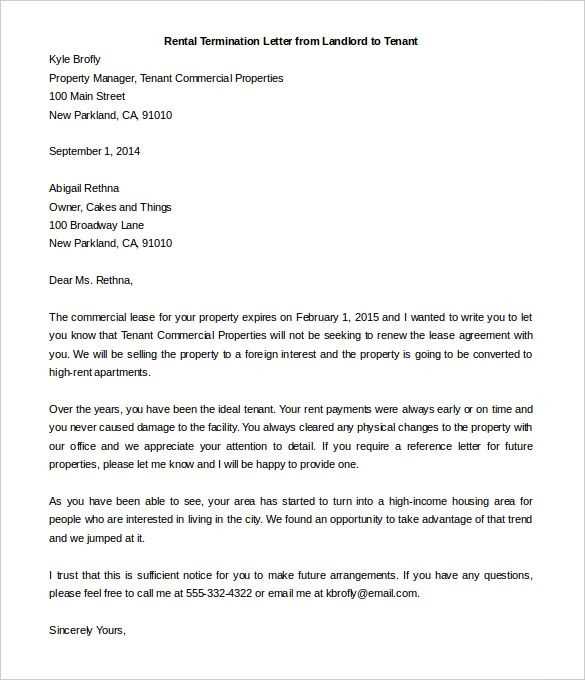Termination of Rental Agreement Letter Template

When the time comes to end a rental arrangement, it’s essential to communicate your decision clearly and professionally. This ensures that both parties understand the terms of departure and avoid misunderstandings. Crafting a well-structured notice is key to a smooth conclusion of the lease.
Understanding the components of an effective notification is crucial. The document should include the necessary details that specify the intended date of departure and any actions required from either party. Being precise and polite will help maintain a positive relationship and ensure a hassle-free transition.
Knowing when and how to submit your notification is also vital. Timeliness is often stipulated by the terms of the lease, and adhering to these guidelines can prevent legal complications or financial penalties. Following a clear process will help you close the agreement with minimal effort and maximum clarity.
How to Write a Rental Termination Letter
When ending a housing contract, clear communication is crucial. A well-written notification can ensure a smooth conclusion for both parties, avoiding any confusion or legal issues. This notice should detail the key information, including the reason for ending the relationship, the date it will be effective, and any other important considerations.
Start with basic information. Begin by including your full name and address, as well as the recipient’s contact details. Clearly state your intention to end the arrangement and provide the date when you plan to vacate the property. This establishes transparency from the start.
Be direct and concise in your message. Avoid unnecessary details, but include anything required by your lease. If applicable, mention any obligations left, such as property maintenance or the return of keys. A straightforward approach ensures that both sides know exactly what to expect moving forward.
Important Elements of the Letter
To create a clear and effective document for ending a lease, certain details must be included. These essential components ensure that both parties understand the terms of the separation and help prevent potential conflicts.
Key Information to Include
Start with clear identification. Make sure to provide your name, address, and contact details, along with the recipient’s information. Additionally, specify the date when the notice is being sent and the intended date of the move-out. This sets a clear timeline for both parties.
Addressing Obligations
Be specific about any responsibilities left before leaving. This may include cleaning, repairs, or returning keys. Clearly mentioning these obligations helps ensure a smooth transition and maintains a positive relationship between the parties.
Common Mistakes to Avoid
When preparing a document to conclude a housing contract, there are several pitfalls to be mindful of. Overlooking key details or making unclear statements can cause confusion and delay the process. Avoiding common errors can help you maintain professionalism and ensure a smooth exit.
Incorrect or Missing Information

It’s important to include all relevant details in the notification. Missing or inaccurate data can lead to misunderstandings or even legal complications. Below is a table outlining some common mistakes to avoid:
| Common Mistake | Consequences |
|---|---|
| Omitting the effective date | Leads to confusion about when the arrangement will officially end. |
| Failure to include contact details | Hinders the ability to communicate if further issues arise. |
| Not specifying remaining obligations | Creates uncertainty about responsibilities after vacating the property. |
Unclear Language and Tone
Being vague or using a harsh tone can also lead to problems. Ensure your wording is straightforward and polite, and avoid any unnecessary emotional language. This will help you maintain a positive relationship and keep the process professional.
When to Send a Termination Notice
Timing is crucial when informing the other party about the end of a housing arrangement. Sending your notification at the right moment ensures that you comply with the contract’s requirements and gives both parties enough time to prepare for the transition.
Check your contract terms to see if there are any specific guidelines about how much notice you need to give. In many cases, this will be a set number of days or months before the intended end date. Failing to meet this requirement could lead to penalties or legal disputes.
Send the notice early enough to allow the recipient time to make necessary preparations. Ideally, this should be done well in advance of the date you plan to vacate. This gives both parties the opportunity to address any remaining obligations or concerns before the arrangement officially ends.
Legal Considerations in Rental Termination

Before ending a housing arrangement, it’s important to understand the legal aspects involved. There are several factors that must be considered to ensure that the process is compliant with local laws and to avoid potential conflicts. Ignoring legal obligations can result in fines, disputes, or loss of deposits.
Here are some key legal points to keep in mind:
- Notice Period: Always review the minimum notice required by the lease. Failing to provide adequate notice may lead to penalties.
- Documentation: Keep copies of any correspondence or notices sent. This can be important if any disagreements arise later.
- Deposit Return: Understand how and when your deposit will be refunded, including any conditions that must be met to avoid deductions.
It’s also essential to verify that all contractual obligations are completed, such as returning keys, paying outstanding bills, or completing property inspections, to ensure the process goes smoothly.
By addressing these legal considerations early, you can avoid unnecessary complications and ensure a respectful, lawful conclusion of the arrangement.
Template for Rental Agreement Cancellation

Having a structured document can simplify the process of ending a housing arrangement. A well-organized format ensures that all necessary details are included, helping both parties understand the expectations clearly and reducing the likelihood of disputes. Below is a simple structure for creating a formal notice to end the arrangement.
Here are the key components to include:
- Your Information: Include your full name, address, and contact details.
- Recipient’s Information: Provide the name and address of the other party involved in the agreement.
- Effective Date: Clearly state the date when you intend to end the arrangement.
- Reason for Ending: While not always required, it can be helpful to briefly explain your reason for leaving.
- Remaining Obligations: Outline any responsibilities you still need to fulfill, such as cleaning or repairs.
- Request for Confirmation: Politely ask the recipient to acknowledge the notice and confirm any follow-up actions.
By following this structure, you ensure all necessary details are addressed, allowing for a smooth and efficient conclusion to the arrangement.
Best Practices for a Smooth Process
To ensure a hassle-free conclusion of your housing arrangement, following a few best practices can make a significant difference. Clear communication, careful planning, and adhering to required procedures can help prevent any issues during the process. These steps promote a professional and respectful transition for both parties.
Start early to give both you and the other party enough time to complete any necessary actions. Whether it’s arranging for an inspection, returning keys, or settling outstanding balances, early communication reduces stress and confusion.
Maintain politeness and professionalism throughout the process. A respectful tone and clear intentions can foster a positive relationship, even after the arrangement ends. This ensures that there are no hard feelings and can be beneficial for potential future interactions.
Lastly, double-check all obligations before officially concluding the arrangement. Make sure all terms are fulfilled and document any final steps taken, such as returning the property in good condition or resolving financial matters. This helps avoid potential disputes later on.